By Ian Stephenson, Planning Convenor, Bulletin 7/2024, September
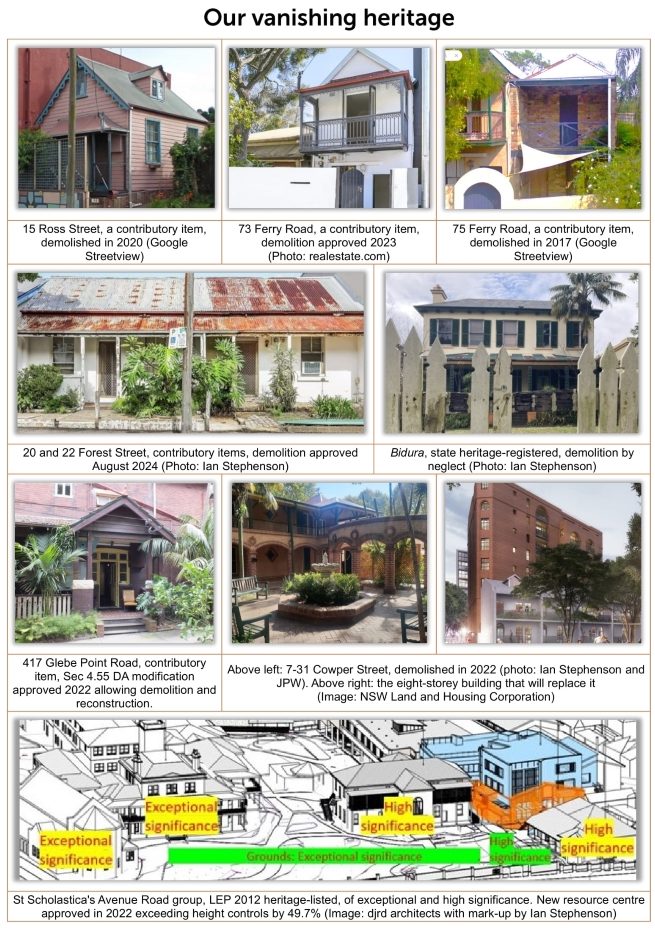
Whether it’s Avenue Road, a fine Edwardian Street with free-standing villas, Boyce Street with its grand three-storey Alberto Terrace, the subtlety of Ferry Road which winds its way down the hill past small and large houses built of timber, brick and stone, the St Phillips estate with its very long rows of terrace houses, the variety of 19th century housing types in Derwent, Westmoreland and Mt Vernon Streets or the mix of workers cottages, villas and terraces in Forest Lodge, Glebe is an exceptional place. Sometimes, we take it for granted, but it is rare and special and an exemplar of how human intelligence can be brought to bear to encourage conservation, sensitive adaption and extension and well-considered infill housing. While the uninformed – let’s call them Urbanus Ignoramus – think we hate change in Glebe, we actually cherish heritage without worshipping at the altar of the Goddess of Stasis.
In Glebe and Forest Lodge’s heritage conservation areas (HCAs), houses can evolve and change, but the adaption needs to be sensitive and appropriate, otherwise we end up throwing the baby out with the bathwater. Property owners are assisted by sensible planning controls for managing things like garages, attic extensions and fences, so the context of our streets is respected. The Sydney Development Control Plan (SDCP), which controls development in HCAs, classifies buildings according to their contribution to the conservation area, including whether they are contributory, neutral or detracting. Contributory buildings predominate in most of our HCAs. In terms of retaining the character of our streets, contributory items are the most important buildings – more important than heritage-listed items because there are more of them. The SDCP recognises their importance in the principle that ‘Contributory buildings are to be retained unless the consent authority determines the replacement is justified in exceptional circumstances’ (Section 3.9.7).
Development applications (DAs) in conservation areas must be accompanied by heritage impact statements (HIS). These are commissioned by the applicant and are sometimes accompanied by engineering reports claiming a house, which has stood the test of time for 150 years, is in danger of immediate collapse. A not-infrequent argument in a HIS is that a house is not a heritage-listed element but only a contributory one, implying that demolition is acceptable. This misses the point that conservation areas are all about context, not individual items.
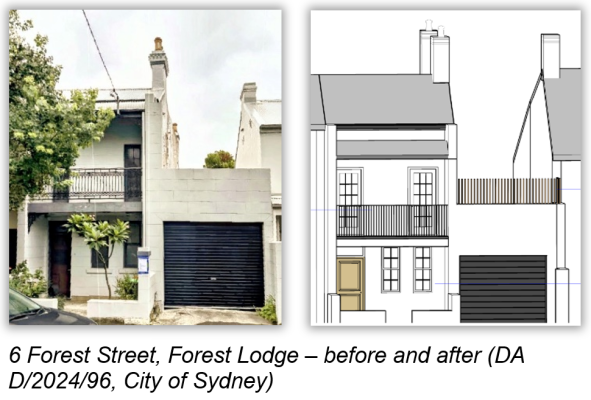 In many ways, Council does a good job in managing this process. The refusal of the application to demolish 181 St Johns Road, Forest Lodge, an 1870s house (although the applicant’s HIS said it dated from the 1910s), is a good example. Recently, at 6 Forest Street, Council negotiated important amendments to a DA, which allowed for changes but retained important character; however, there were also notable losses.
In many ways, Council does a good job in managing this process. The refusal of the application to demolish 181 St Johns Road, Forest Lodge, an 1870s house (although the applicant’s HIS said it dated from the 1910s), is a good example. Recently, at 6 Forest Street, Council negotiated important amendments to a DA, which allowed for changes but retained important character; however, there were also notable losses.
At least five contributory houses have been either demolished or approved for demolition in the last five years. In Ferry Road, three contiguous houses, number 71 (a neutral item) and numbers 73 and 75 (both contributory items), have been demolished or approved for demolition. The effects can be cumulative and create precedents that lead to the loss of adjoining contributory houses. Number 75 is a small house built at the front of a long block. The Society felt the opportunity existed to keep the main portion of the old house and build behind it. Perversely, the structural report, which was commissioned by the applicant, justified the demolition of this contributory building by stating that the demolition of number 73 Ferry Road (also a contributory building) and the excavation on that site had cracked the foundations of number 75.
Forest Street demolitions
Recently, Council reached agreement with the applicants at 20 and 22 Forest Street to demolish a pair of 1870s contributory cottages. The DA was first lodged in May 2023. Based on the ‘deemed refusal’ provisions in the Environmental Planning and Assessment Act, the developer appealed to the Land and Environment Court (LAEC) before Council had made its determination. In July 2024, the applicant lodged amended plans with Council. These still involved demolishing the contributory houses but included a more sympathetic design for the street elevation of the new building. Council accepted the modified scheme in the conciliation process, and the plans were later approved by the LAEC. The Society felt that the core of the houses could have been retained and adapted as part of the development since they were located close to the street and occupied only about 25% of the site.
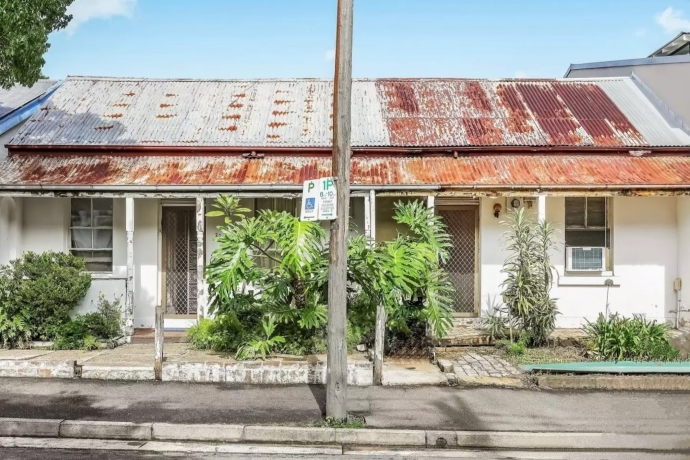
The structural report in the DA for 20-22 Forest Street, commissioned by the applicant, contained factual errors and, on the report authors’ own admission, did not include an inspection of the roofing timbers and the sub-floor spaces. The report concluded that the houses were at risk of collapse. In our assessment the evidence cited did not support this conclusion. We recommended that Council commission a structural peer review by a heritage engineer. We feel that engineering reports commissioned by applicants to justify the demolition of contributory buildings need to be independently reviewed if Council is to have assurance that the ‘exceptional circumstances’ test in the SDCP has been satisfied.
Number 18 Forest Street is another single-story cottage from the 1870s and is also a contributory building. With numbers 20 and 22, there was a row of three such houses, but now there will only be one. The development of numbers 20 and 22 involves an excavation. One hopes this will not damage the footings of number 18, which will be the only surviving house from this group of three 150-year-old contributory buildings.
St Scholastica’s heritage group
I mentioned Avenue Road at the start of this article. A Council study describes it as one of Sydney’s most important turn-of-the-century townscapes with a high degree of architectural intactness. The street’s western side comprises the unusually rich St Scholastica’s heritage group, an ensemble of buildings and landscape identified as having exceptional and high heritage significance. The group is listed as heritage item I653 (‘St Scholastica’s College including buildings and their interiors, fencing and grounds’) in the Sydney Local Environment Plan 2012 (Schedule 5).
While the College’s campus has suffered ad hoc development on its western side (not unusual in the evolution of schools), the Avenue Road frontage is very harmonious. It has an ensemble of buildings dating from 1829 (Toxteth Park), 1899 (Wych Wood), 1902 (Administration Building) and 1931 (the Chapel) set in beautifully landscaped grounds. Clearly, the Sisters of the Good Samaritan who ran the school for most of its history had a love of heritage and tradition, which they integrated with their mission of educating young women. They successfully managed the site’s heritage while sensitively responding to the demands for new buildings.
Some years ago, the school commissioned Design5 which is led by the eminent conservation architect Alan Croker, Lyndhurst and the Sydney Opera House are clients, to do a conservation and management plan (CMP) for St Scholastica’s. It included a master plan that sensibly identified future development sites so that taller buildings would not impact the views of the heritage-listed St Scholastica’s group from Avenue Road. It was disappointing that in 2022 the City of Sydney Local Planning Panel (LPP), contrary to the principles in the CMP, approved the erection in the Avenue Road viewshed of a four-storey multi-purpose building that exceeds the height control by 50%.
This huge departure from the statutory height limit relied on accepting that it met the standards for a Section 4.6 variation under the NSW Environmental Planning and Assessment Act. Section 4.6 says a development standard can be varied if compliance with the standard is unreasonable or unnecessary and sufficient environmental grounds exist to justify contravening it. In this case, deviating from the standard was unnecessary because alternative development sites on the campus had been identified in the CMP which would not compromise the Avenue Road frontage. It was also unreasonable because it detracted unnecessarily from the significance of the St Scholastica’s heritage listing which includes buildings and grounds. The listing recommended that a CMP be prepared before any major works are undertaken. A CMP was prepared, and it identified a number of suitable development sites on the campus for taller buildings; however this recommendation was ignored, and the building was approved in the wrong place. This is a significant failure of planning. It should also be noted that exceeding the height control by 50% is an unusually large variation.
Whilst the decision was made by the LPP, Council must also bear some responsibility as they recommended to the LPP that the proposal be approved.

St Phillips and Lyndhurst Heritage Conservation Areas
Developments at 17-31 Cowper Street in the St Phillips HCA and 82 Wentworth Park Road in the Lyndhurst HCA present some of the most serious threats to the context of Glebe. Here, well-built and well-designed, sensitive infill public housing from the 1980s has been demolished or approved for demolition and is being replaced by buildings that do not respect their setting.
The Society commissioned an alternative scheme from Hector Abrahams Architects for 82 Wentworth Park Road which showed that the existing building, with its 27 bedrooms, could be kept and a new building built at the rear of the site with an additional 24 bedrooms, making a total of 51 bedrooms. The NSW Land and Housing Corporation (now Homes NSW) lodged a development application with the Sydney City Council to demolish the existing building and replace it with a new building that will provide 52 bedrooms, only one more than the alternative scheme. It was a contentious DA, with a total of 374 submissions being lodged.
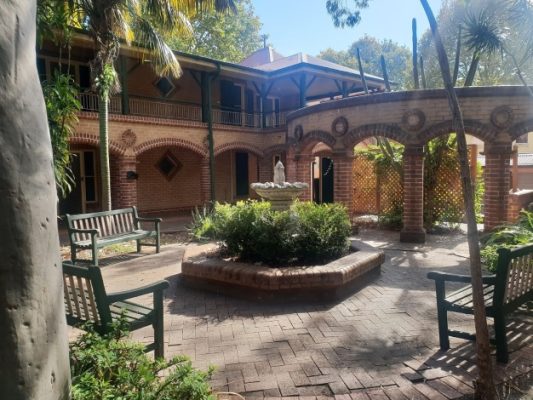
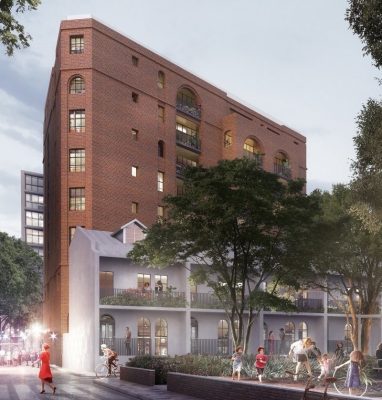
The application was heard by the City of Sydney LPP on 13 December 2024. The Environmental Planning and Assessment Act does not allow a consent authority ‘to refuse its consent to a Crown development application, except with the approval of the Minister’ or to ‘impose a condition on its consent to a Crown development application, except with the approval of the applicant or the Minister’.
Despite this, two members of the four-member panel declined to approve the application because it actually reduces the supply of public housing during a housing crisis. One said: ‘Why demolish those? Why go through the whole destruction of the embodied energy in those houses and the energy required both to demolish and rebuild?’ Another said: ‘I’ve heard lots of intelligent reasons why we should be renovating and adding on that site. I think it’s better for the streetscape. It’s a better imperative for Glebe to have these familiar buildings. I agree about the really pressing sustainability issues of demolishing. In addition, the new building has numerous non-compliances [these include not meeting minimum standards of sunlight in mid-winter]. It’s tragic these apartments are sitting there empty amongst a whole lot of homeless people. The idea that we would add another two or three years to that travesty when we don’t need to, I just cannot support’.
The Society was very grateful to the leadership provided by the City of Sydney that passed a motion on 11 December 2023 commending the community’s alternative vision for 82 Wentworth Park Road and asked the NSW Minister for Housing to consider upgrading and refurbishing buildings over demolition in all future Land and Housing Corporation redevelopments, including at 82 Wentworth Park Road Glebe.
We were subsequently advised by the Minister for Housing that her department’s analysis showed that it was cheaper to demolish and rebuild than to refurbish and extend. The arguments proposed were riddled with fallacies and bias, and there was no transparency. We were not, for example, given access to their quantity surveyors’ reports (see glebesociety.org.au/da-outcome-82-wentworth-park-road/). The DA was approved as a deferred commencement pending the completion of a stormwater plan and structural report. The property has been leased to Bridge Housing for twelve months to accommodate people in housing need and is now expected to be demolished in mid-2025.
It is a rough road that leads to the heights of greatness
The Roman philosopher Seneca was writing about the need for perseverance. This is something the people of Glebe have proved many times over and in many ways, including in the quest to save our suburb from dismemberment by freeways, transforming an industrial foreshore into a linear harbourside park, regenerating urban bushland and fostering bio-diversity, managing change in a clever way which conserves our amazing built heritage and nurturing our diverse community.
14 September 2024 is polling day for the City of Sydney. We invite our Councillors and Lord Mayor to traverse the road to greatness by implementing stronger procedures to protect contributory buildings in Glebe’s heritage conservation areas and continuing to show leadership and vision in persuading Homes NSW to refurbish and extend public housing in Glebe by sensitive infill – not to adopt the scorched earth policy of demolition.



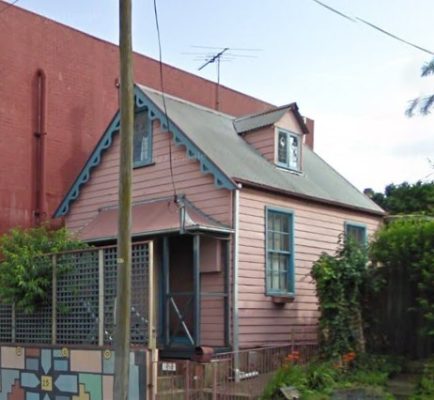
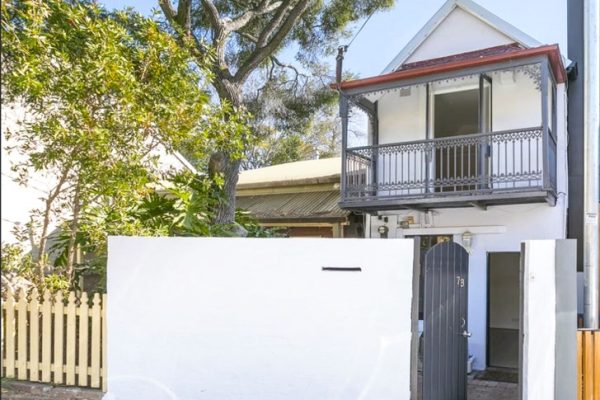
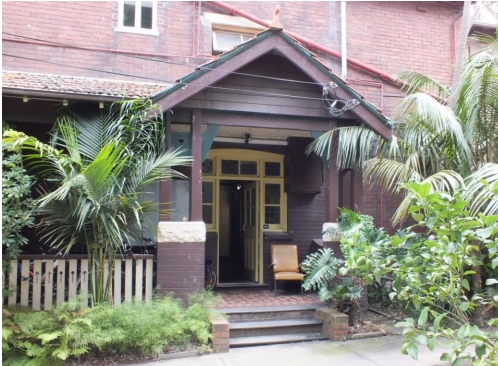





There are no comments yet. Please leave yours.